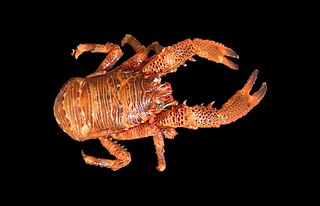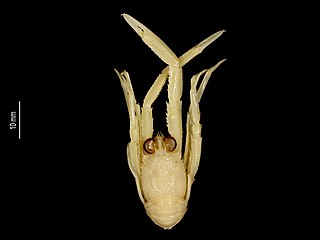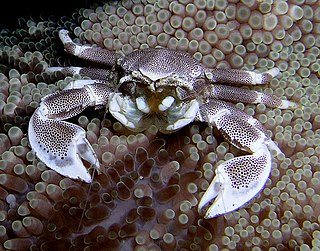
Squat lobsters are dorsoventrally flattened crustaceans with long tails held curled beneath the cephalothorax. They are found in the two superfamilies Galatheoidea and Chirostyloidea, which form part of the decapod infraorder Anomura, alongside groups including the hermit crabs and mole crabs. They are distributed worldwide in the oceans, and occur from near the surface to deep sea hydrothermal vents, with one species occupying caves above sea level. More than 900 species have been described, in around 60 genera. Some species form dense aggregations, either on the sea floor or in the water column, and a small number are commercially fished.

Galathea is a genus of squat lobsters in the family Galatheidae. It is one of the largest genera of squat lobsters that in 2008 contained 70 species. Most species of Galathea live in shallow waters.

Munidopsis serricornis is a species of squat lobster. It is widely distributed in the world's oceans, being found in the eastern Atlantic Ocean, the western Atlantic Ocean, and the Indo-Pacific. It grows up to a carapace length of 20 millimetres (0.8 in).

Munidopsis is a genus of squat lobster. It is the second largest of all the genera of squat lobsters, after Munida, with over 200 species. Its members are mainly found on continental slopes and on abyssal plains. A few fossil species are also known, including specimens from the Campanian (Cretaceous).

Allogalathea elegans is a species of squat lobster that is sometimes kept in marine aquariums. Despite their common name, they are more closely related to hermit crabs than lobsters.
Anomoeomunida is a monotypic squat lobster genus in the family Munididae. The sole a species of is Anomoeomunida caribensis. It occurs in the western Atlantic.

Coralliogalathea is a genus of squat lobsters in the family Galatheidae. Initially thought to be monotypic, solely represented by Coralliogalathea humilis, recent analysis has split the genus into six, morphologically similar but genetically different species.

Heteronida is a genus of squat lobsters in the family Munididae. They occur in the western Pacific Ocean.

Plesionida is a genus of squat lobsters in the family Munididae. As of 2017, it contains the following species:

Raymunida is a genus of squat lobsters in the family Munididae, containing the following 11 species:

The Galatheoidea are a superfamily of decapod crustaceans comprising the porcelain crabs and some squat lobsters. Squat lobsters within the three families of the superfamily Chirostyloidea are not closely related to the squat lobsters within the Galatheoidea. The fossil record of the superfamily extends back to the Middle Jurassic genus Palaeomunidopsis.

Munididae is a family of squat lobsters, taxonomically separated from the family Galatheidae in 2010.

Lauriea siagiani, also known as the pink hairy squat lobster or the fairy crab, is a species of squat lobster in the family Galatheidae, genus Lauriea.
Munidopsis tuberosa is a species of squat lobster, first isolated from deep waters off Taiwan. M. tuberosa is similar to M. granosicorium, but it differs by the configuration of its carapace and rostrum.
Munidopsis echinata is a species of squat lobster, first found in deep waters off Taiwan. M. echinata is similar to M. colombiana, but differs by lacking an antennal spine on its carapace and having a rather longer antennal peduncle.
Uroptychus singularis is a species of chirostylid squat lobster first found in Taiwan. This species is distinguished from U. australis by its single, unpaired terminal spine on its flexor margin of pereopods 2–4.
Munidopsis tafrii is a species of squat lobster first found in Taiwanese waters at depths greater than 3,000 metres (9,800 ft). It resembles M. ceratophthalma, however its carapace morphology distinguishes it from its cogenerate species.
Raymunida erythrina is a species of squat lobster in the family Munididae from the Pacific and Indian oceans. The species can be distinguished by its morphological characters and its mitochondrial cytochrome c oxidase subunit I sequences.

Raymunida dextralis is a species of squat lobster in the family Munididae from the Pacific and Indian oceans. The species can be distinguished by its morphological characters and its mitochondrial cytochrome c oxidase subunit I sequences.

Raymunida confundens is a species of squat lobster in the family Munididae from the Pacific and Indian oceans. The species can be distinguished by its morphological characters and its mitochondrial cytochrome c oxidase subunit I sequences.











